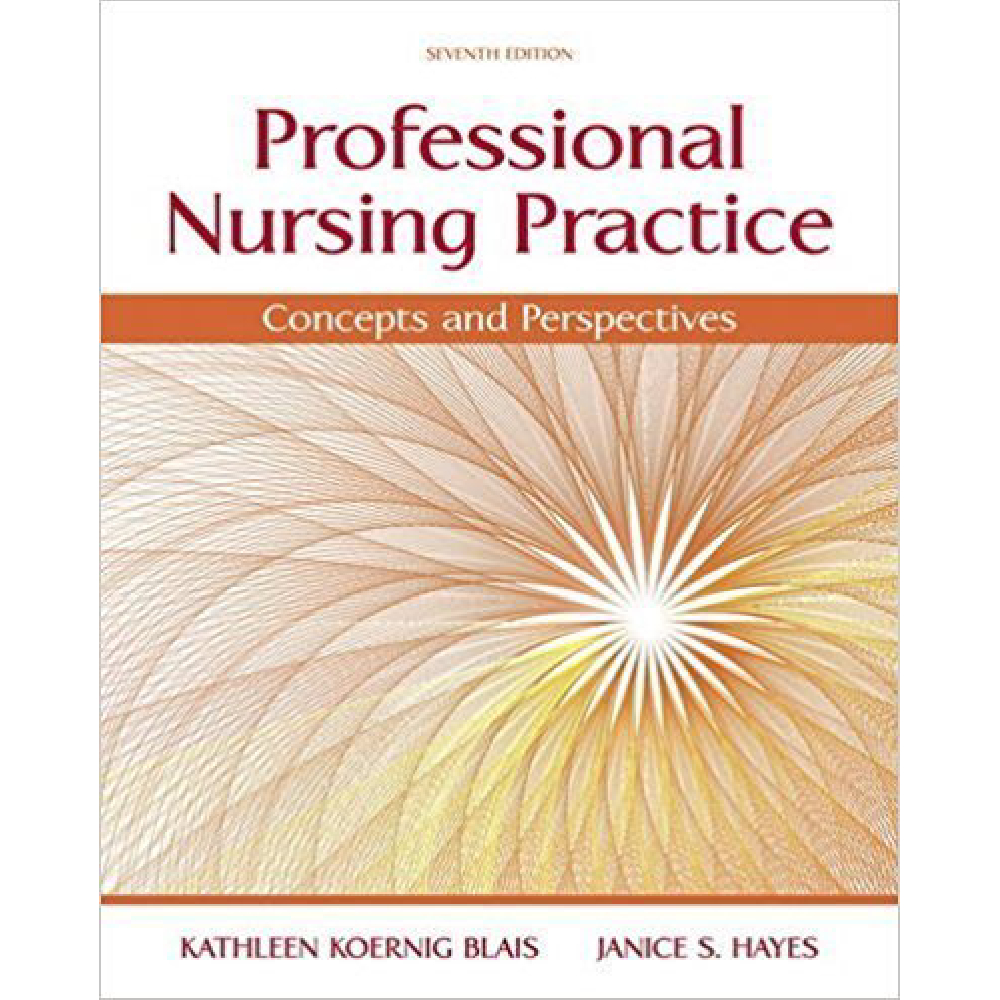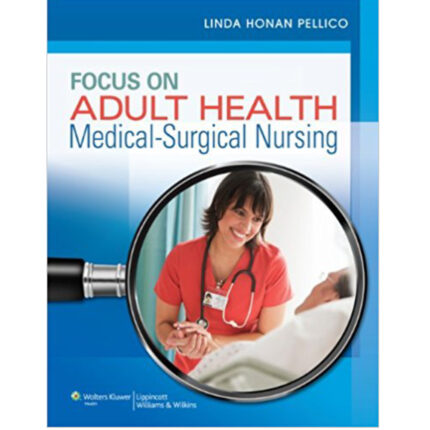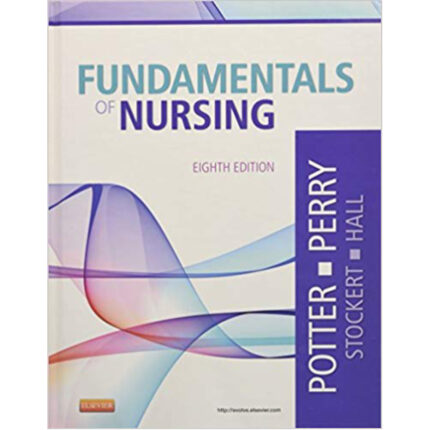Professional Nursing Practice Concepts And Perspectives 7th Edition By Blais – Test Bank
Chapter 11: The Nurse’s Role in Quality and Safety
Question 1
The nurse receives the report for a client recovering from a repair of a fractured hip, who is being transferred to the orthopedic care area. The following information was obtained in the telephone report:
Report received 14:00 hours: 76-year-old female; ORIF of right hip caused by falling in the home; receiving Morphine sulfate 2 mg IV every 4 to 6 hours for pain; difficult to keep turned on non-operative site; indwelling urinary catheter in place; Hgb 10 after 2 units PRBCs post-operatively.
Which National Patient Safety goals should the nurse make a priority for this client? (Select all that apply.)
1. Prevent wrong site/procedure/person surgery.
2. Prevent health-care associated pressure ulcers.
3. Improve the accuracy of patient identification.
4. Reduce the risk of patient harm resulting from falls.
5. Reduce the risk of health care-associated infections.
Correct Answer: 2, 4, 5
Rationale: Because the client is difficult to keep turned on the non-operative site, the goal to prevent health-care associated pressure ulcers (decubitus ulcers) should be a priority. Because the client has fallen in the home and is recovering from surgery to repair a fracture from a fall, the goal to reduce the risk of patient harm resulting from falls should be a priority. Because the client has an indwelling urinary catheter, the goal to reduce the risk of health care-associated infections should be a priority. Preventing wrong site, wrong procedure, and wrong person surgery would have been appropriate preoperatively. There is no reason to think that the accuracy of patient identification needs to be improved for this client.
Cognitive Level: Applying
Client Need: Safe and Effective Care Environment
Client Need Sub: Safety and Infection Control
QSEN Competencies: V.B.1. Demonstrate effective use of technology and standardized practices that support safety and quality.
AACN Essential Competencies: II.5. Participate in quality and patient safety initiatives, recognizing that these are complex system issues, which involve individuals, families, groups, communities, populations, and other members of the healthcare team.
NLN Competencies: Quality and Safety; Knowledge; Factors that contribute to a system-wide safety culture; Importance of reporting hazards and adverse events; “Just culture“ approach to system improvement.
Nursing/Integrated Concepts: Implementation; Nursing Process
Learning Outcome: 1. Discuss regulatory and professional standards that guide patient safety and quality of care.
Page Number: p. 211
Question 2
The charge nurse is beginning rounds after attending morning report. Which clients should the nurse be concerned for developing a never event? (Select all that apply.)
1. Client with hemophilia receiving Factor replacement transfusions
2. Client recovering from a stroke with foul-smelling urine in a catheter drainage bag
3. Client recovering from total knee replacement surgery complaining of right calf pain
4. Client with heart failure being fitted for a C-pap mask for use at home for sleep apnea
5. Client with renal failure with a newly diagnosed stage III pressure ulcer on the left heel
Correct Answer: 2, 3, 5
Rationale: The Centers for Medicare and Medicaid Services (CMS) issued a ruling to deny reimbursement of federal funds to pay for services by physicians and hospitals for treatment of never events, which are preventable errors, injuries, and infections. These events include urinary tract infections, deep vein thrombosis, and pressure ulcers. The client with hemophilia and the client being fitted for a device to prevent sleep apnea are less at risk for developing a never event.
Cognitive Level: Analyzing
Client Need: Safe and Effective Care Environment
Client Need Sub: Safety and Infection Control
QSEN Competencies: V.B.1. Demonstrate effective use of technology and standardized practices that support safety and quality.
AACN Essential Competencies: II.5. Participate in quality and patient safety initiatives, recognizing that these are complex system issues, which involve individuals, families, groups, communities, populations, and other members of the healthcare team.
NLN Competencies: Quality and Safety; Knowledge; Factors that contribute to a system-wide safety culture; Importance of reporting hazards and adverse events; “Just culture” approach to system improvement.
Nursing/Integrated Concepts: Assessment; Nursing Process
Learning Outcome: 1. Discuss regulatory and professional standards that guide patient safety and quality of care.
Page Number: p. 213
Question 3
The director of nursing is searching for information about the Consumer Assessment of Health Plans. Which organization website should the director access for this information?
1. Joint Commission (TJC)
2. Centers for Medicare and Medicaid Services (CMS)
3. National Association for Healthcare Quality (NAHQ)
4. Agency for Healthcare Research and Quality (AHRQ)
Correct Answer: 4
Rationale: AHRQ is foundational in developing quality-of-care indicators and is responsible for the Consumer Assessment of Health Plans (CAHPS). The National Association for Healthcare Quality (NAHQ) is the professional organization for healthcare quality professionals, publishes the Journal for Healthcare Quality (JHQ), and provides a number of products focused on continuous quality improvement (CQI) in healthcare teams. The Joint Commission and Centers for Medicare and Medicaid do not participate in the Consumer Assessment of Health Plans.
Cognitive Level: Applying
Client Need: Safe and Effective Care Environment
Client Need Sub: Safety and Infection Control
QSEN Competencies: V.B.1. Demonstrate effective use of technology and standardized practices that support safety and quality.
AACN Essential Competencies: II.5. Participate in quality and patient safety initiatives, recognizing that these are complex system issues, which involve individuals, families, groups, communities, populations, and other members of the healthcare team.
NLN Competencies: Quality and Safety; Knowledge; Factors that contribute to a system-wide safety culture; Importance of reporting hazards and adverse events; “Just culture” approach to system improvement.
Nursing/Integrated Concepts: Assessment; Nursing Process
Learning Outcome: 1. Discuss regulatory and professional standards that guide patient safety and quality of care.
Page Number: p. 214
Question 4
The staff development trainer is preparing information for a seminar on the Quality and Safety Education for Nurses (QSEN) initiative as part of the National Safety Week celebration. Which attributes should the trainer emphasize as being an integral part of this initiative? (Select all that apply.)
1. Skills
2. Caring
3. Attitudes
4. Education
5. Knowledge
Correct Answer: 1, 4, 5
Rationale: The focus of the QSEN Institute is to meet “the challenge of preparing future nurses with the knowledge, skills, and attitudes (KSAs) necessary to continuously improve the quality and safety of the healthcare systems within which they work.” Caring and education are not attributes within the QSEN Institute.
Cognitive Level: Applying
Client Need: Safe and Effective Care Environment
Client Need Sub: Safety and Infection Control
QSEN Competencies: V.B.1. Demonstrate effective use of technology and standardized practices that support safety and quality.
AACN Essential Competencies: II.5. Participate in quality and patient safety initiatives, recognizing that these are complex system issues, which involve individuals, families, groups, communities, populations, and other members of the healthcare team.
NLN Competencies: Quality and Safety; Knowledge; Factors that contribute to a system-wide safety culture; Importance of reporting hazards and adverse events; “Just culture” approach to system improvement.
Nursing/Integrated Concepts: Implementation; Teaching/Learning
Learning Outcome: 1. Discuss regulatory and professional standards that guide patient safety and quality of care.
Page Number: p. 215
Question 5
At the completion of orientation the new graduate is completing a written test that focuses on the QSEN competencies. Which statements should the nurse identify as describing these competencies? (Select all that apply.)
1. Minimizes the risk of harm
2. Functions within interprofessional teams
3. Follows time-out protocols as appropriate
4. Uses data to monitor the outcomes of care processes
5. Integrates the best current evidence with clinical expertise
Correct Answer: 1, 2, 4, 5
Rationale: Functioning within interprofessional teams describes Teamwork and Collaboration. Integrating the best current evidence with clinical expertise describes Evidence-Based Practice. Using data to monitor the outcomes of care processes describes Quality Improvement. Minimizing the risk of harm describes Safety. Following time-out protocols is a National Patient Safety Goal used before surgery or a procedure.
Cognitive Level: Applying
Client Need: Safe and Effective Care Environment
Client Need Sub: Safety and Infection Control
QSEN Competencies: V.B.1. Demonstrate effective use of technology and standardized practices that support safety and quality.
AACN Essential Competencies: II.5. Participate in quality and patient safety initiatives, recognizing that these are complex system issues, which involve individuals, families, groups, communities, populations, and other members of the healthcare team.
NLN Competencies: Quality and Safety; Knowledge; Factors that contribute to a system-wide safety culture; Importance of reporting hazards and adverse events; “Just culture” approach to system improvement.
Nursing/Integrated Concepts: Assessment; Nursing Process
Learning Outcome: 1. Discuss regulatory and professional standards that guide patient safety and quality of care.
Page Number: p. 215
Question 6
The Quality Improvement committee is identifying indicators as measures of health care. What should the committee identify as characteristics of quality indicators? (Select all that apply.)
1. Identify nurses’ roles
2. Readily available data
3. Focus on priority areas
4. Scientifically acceptable
5. Useful for decision making
Correct Answer: 2, 3, 4, 5
Rationale: The National Quality Forum endorses a wide range of quality indicators as measures of health care and has established specific criteria. Quality indicators should be: Important to measure and report to keep our focus on priority areas, where the evidence is highest that measurement can have a positive impact on healthcare quality. Scientifically acceptable so that the measure, when implemented, will produce consistent (reliable) and credible (valid) results about the quality of care. Useable and relevant to ensure that intended users—consumers, purchasers, providers, and policy makers—can understand the results of the measure, and are likely to find them useful for quality improvement and decision making. Feasible to collect with data that can be readily available for measurement and retrievable without undue burden. Nurses’ roles are not criteria when identifying characteristics of quality indicators.
Cognitive Level: Applying
Client Need: Safe and Effective Care Environment
Client Need Sub: Safety and Infection Control
QSEN Competencies: V.B.1. Demonstrate effective use of technology and standardized practices that support safety and quality.
AACN Essential Competencies: II.5. Participate in quality and patient safety initiatives, recognizing that these are complex system issues, which involve individuals, families, groups, communities, populations, and other members of the healthcare team.
NLN Competencies: Quality and Safety; Knowledge; Factors that contribute to a system-wide safety culture; Importance of reporting hazards and adverse events; “Just culture” approach to system improvement.
Nursing/Integrated Concepts: Assessment; Nursing Process
Learning Outcome: 2. Analyze ways in which safety and quality of care can be evaluated.
Page Number: p. 215
Question 7
The staff on a care area expresses dissatisfaction with participating in data collection of quality indicators. What should the manager explain as reasons to measure quality? (Select all that apply.)
1. Pay for performance
2. Public accountability
3. Determine staffing needs
4. Drive quality improvement
5. Inform consumer decisions
Correct Answer: 1, 2, 4, 5
Rationale: Measures of quality are used for multiple purposes: 1. to drive quality improvement; 2. for public accountability; 3. to inform consumer decisions; and 4. to pay for performance. Measures of quality are not used to determine staffing needs.
Cognitive Level: Applying
Client Need: Safe and Effective Care Environment
Client Need Sub: Safety and Infection Control
QSEN Competencies: V.B.1. Demonstrate effective use of technology and standardized practices that support safety and quality.
AACN Essential Competencies: II.5. Participate in quality and patient safety initiatives, recognizing that these are complex system issues, which involve individuals, families, groups, communities, populations, and other members of the healthcare team.
NLN Competencies: Quality and Safety; Knowledge; Factors that contribute to a system-wide safety culture; Importance of reporting hazards and adverse events; “Just culture” approach to system improvement.
Nursing/Integrated Concepts: Implementation; Nursing Process
Learning Outcome: 2. Analyze ways in which safety and quality of care can be evaluated.
Page Number: p. 216
Question 8
The vice president of nursing is curious about the quality performance of the cardiovascular intensive care program as compared with other major city hospitals. Which resource should the vice president use to determine this performance?
1. National Quality Forum
2. Quality and Safety Education for Nurses
3. Agency for Healthcare Research and Quality
4. National Database of Nursing Quality Indicators
Correct Answer: 4
Rationale: The National Database of Nursing Quality Indicators (NDNQI) is the primary registry for nursing-sensitive indicators. The nursing-sensitive indicators represent the structure, process, and outcomes of nursing care and are reported at a unit level. Comparisons can be made at the state, national, and regional level. Similar units and facilities are compared on specific indicators. The National Quality Forum endorses a wide range of quality indicators as measures of health care and has established specific criteria. Quality and Safety Education for Nurses (QSEN) led the nationwide effort to develop quality and safety competencies and content that can be integrated into the nursing education curriculum. Agency for Healthcare Research and Quality (AHRQ) is the primary governmental agency focused on designing research to improve safety and quality of care, control costs, and increase access to essential services.
Cognitive Level: Applying
Client Need: Safe and Effective Care Environment
Client Need Sub: Safety and Infection Control
QSEN Competencies: V.B.1. Demonstrate effective use of technology and standardized practices that support safety and quality.
AACN Essential Competencies: II.5. Participate in quality and patient safety initiatives, recognizing that these are complex system issues, which involve individuals, families, groups, communities, populations, and other members of the healthcare team.
NLN Competencies: Quality and Safety; Knowledge; Factors that contribute to a system-wide safety culture; Importance of reporting hazards and adverse events; “Just culture” approach to system improvement.
Nursing/Integrated Concepts: Implementation; Nursing Process
Learning Outcome: 2. Analyze ways in which safety and quality of care can be evaluated.
Page Number: p. 217
Question 9
During an emergency room visit a client refuses to be admitted because of information learned over the internet about the care of clients with the same health problem. To what should the nurse realize that the client is referring?
1. Report card
2. KSA behaviors
3. Health care claims
4. QSEN competencies
Correct Answer: 1
Rationale: Report cards typically include selected quality indicators or measures developed and endorsed broadly by agencies such as the NQF, AHRQ, and CMS. Data are organized and presented based on disease conditions, procedures, quality and safety, nurse staffing, patient satisfaction, and costs of services. Consumers can determine how often the recommended treatments were provided for patients admitted to a specific facility. KSA behaviors and QSEN competencies address quality and safety education for nursing students. Health care claims would not necessarily address quality information.
Cognitive Level: Analyzing
Client Need: Safe and Effective Care Environment
Client Need Sub: Safety and Infection Control
QSEN Competencies: V.B.1. Demonstrate effective use of technology and standardized practices that support safety and quality.
AACN Essential Competencies: II.5. Participate in quality and patient safety initiatives, recognizing that these are complex system issues, which involve individuals, families, groups, communities, populations, and other members of the healthcare team.
NLN Competencies: Quality and Safety; Knowledge; Factors that contribute to a system-wide safety culture; Importance of reporting hazards and adverse events; “Just culture” approach to system improvement.
Nursing/Integrated Concepts: Assessment; Nursing Process
Learning Outcome: 2. Analyze ways in which safety and quality of care can be evaluated.
Page Number: p. 218
Question 10
The nurse manager is reviewing an occurrence report written after a client fall. For which personal factors should the manager consider as contributing to this occurrence? (Select all that apply.)
1. Patient consumed 75% of last meal
2. Patient’s team leader a new graduate
3. Unlicensed assistive personnel assigned working a double shift
4. “Ambulate with assistance” not written on the Kardex care plan
5. Patient being discharged to a skilled nursing facility the next day
Correct Answer: 2, 3, 4
Rationale: Factors that contribute to adverse events include human factors such as teamwork, communication, fatigue, stress, and burnout. The new graduate could be stressed or having difficulty with teamwork or communication. UAP working a double shift could contribute to fatigue. Missing information on the care plan regarding ambulation could contribute to communication. The client’s appetite and discharge plans were most likely not human factors that contributed to the occurrence.
Cognitive Level: Analyzing
Client Need: Safe and Effective Care Environment
Client Need Sub: Safety and Infection Control
QSEN Competencies: V.B.1. Demonstrate effective use of technology and standardized practices that support safety and quality.
AACN Essential Competencies: II.5. Participate in quality and patient safety initiatives, recognizing that these are complex system issues, which involve individuals, families, groups, communities, populations, and other members of the healthcare team.
NLN Competencies: Quality and Safety; Knowledge; Factors that contribute to a system-wide safety culture; Importance of reporting hazards and adverse events; “Just culture” approach to system improvement.
Nursing/Integrated Concepts: Assessment; Nursing Process
Learning Outcome: 3. Explain system and personnel factors that affect safety and quality of care.
Page Number: p. 208













Reviews
There are no reviews yet.